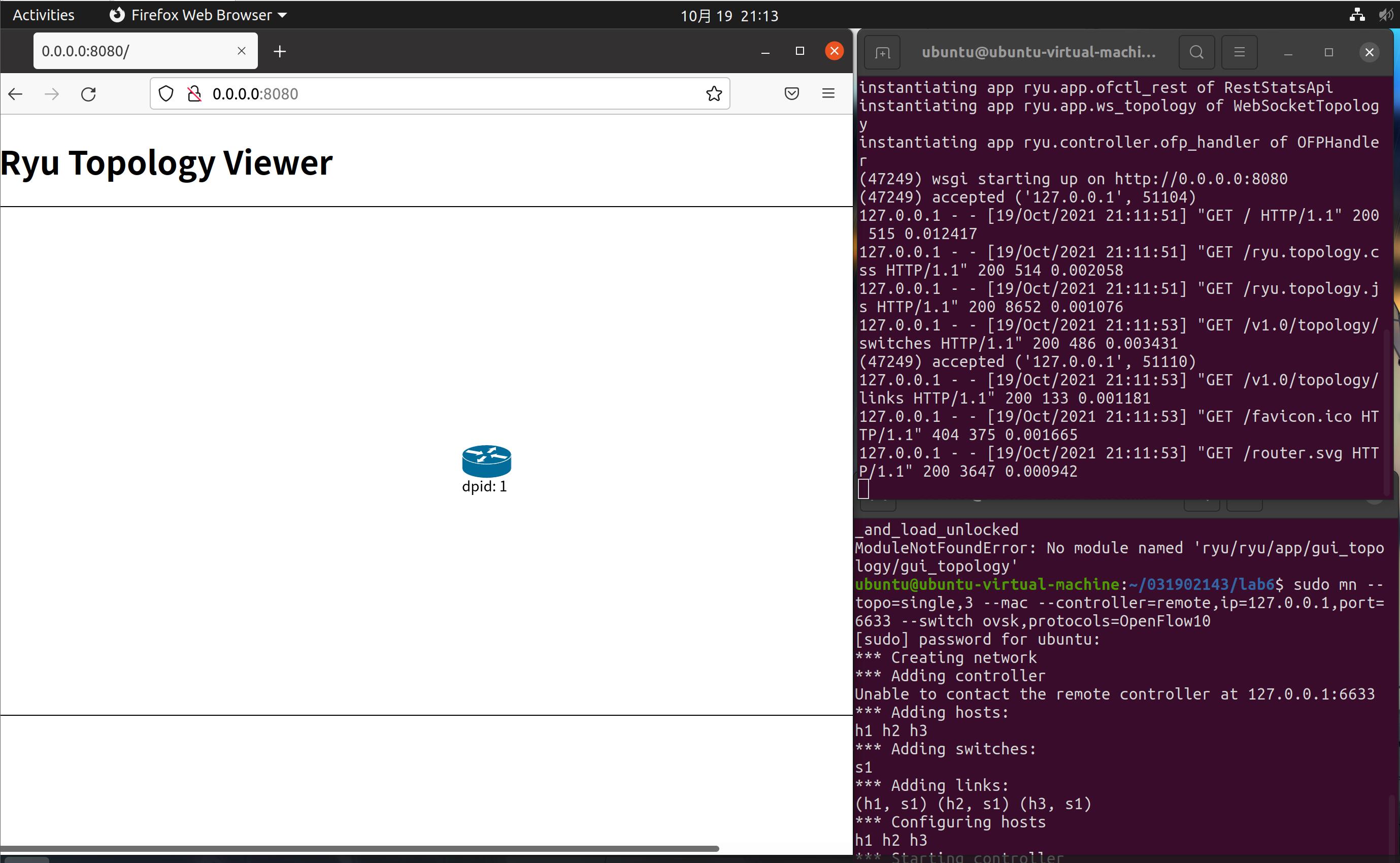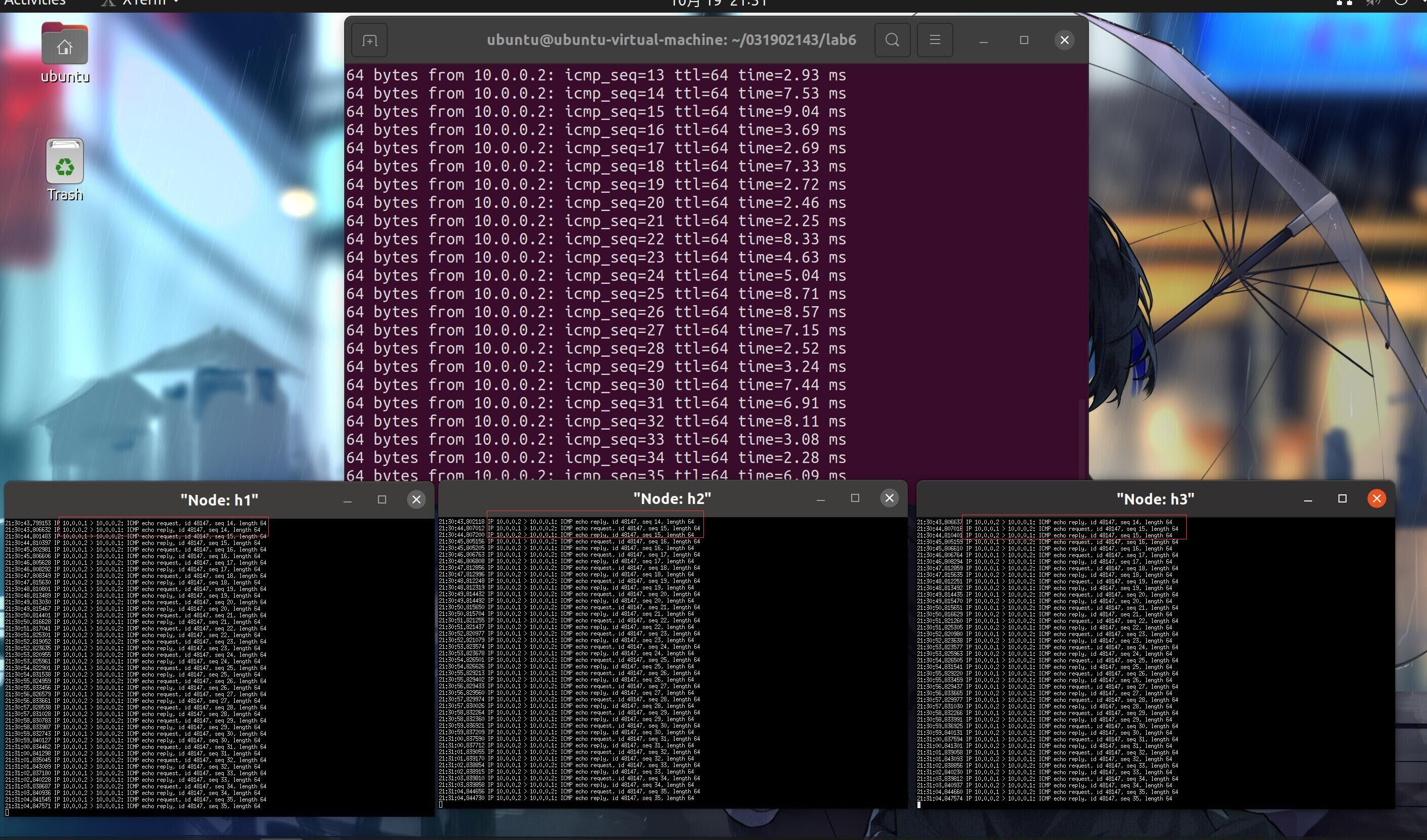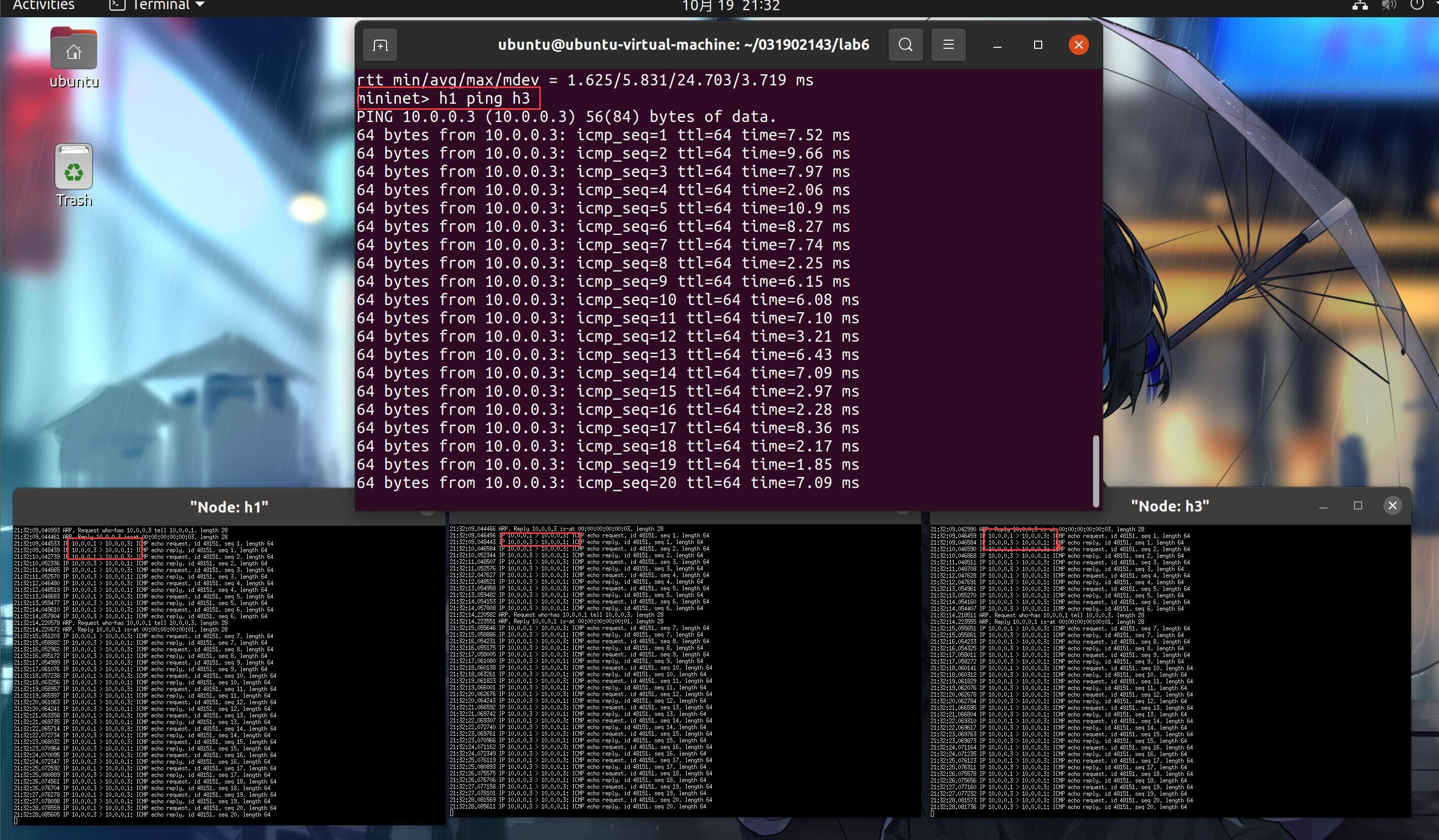实验6:开源控制器实践——RYU
实验6:开源控制器实践——RYU
一、实验目的
- 能够独立部署RYU控制器;
- 能够理解RYU控制器实现软件定义的集线器原理;
- 能够理解RYU控制器实现软件定义的交换机原理。
二、实验环境
- 下载虚拟机软件Oracle VisualBox或VMware;
- 在虚拟机中安装Ubuntu 20.04 Desktop amd64,并完整安装Mininet;
三、实验要求
(一)基本要求
-
完成Ryu控制器的安装。

-
搭建下图所示SDN拓扑,协议使用Open Flow 1.0,并连接Ryu控制器。

-
通过Ryu的图形界面查看网络拓扑。

-
阅读Ryu文档的The First Application一节,运行并使用 tcpdump 验证L2Switch,分析和POX的Hub模块有何不同。
编写程序,命名为L2Switch
from ryu.base import app_manager from ryu.controller import ofp_event from ryu.controller.handler import MAIN_DISPATCHER from ryu.controller.handler import set_ev_cls from ryu.ofproto import ofproto_v1_0 class L2Switch(app_manager.RyuApp): OFP_VERSIONS = [ofproto_v1_0.OFP_VERSION] def __init__(self, *args, **kwargs): super(L2Switch, self).__init__(*args, **kwargs) @set_ev_cls(ofp_event.EventOFPPacketIn, MAIN_DISPATCHER) def packet_in_handler(self, ev): msg = ev.msg dp = msg.datapath ofp = dp.ofproto ofp_parser = dp.ofproto_parser actions = [ofp_parser.OFPActionOutput(ofp.OFPP_FLOOD)] data = None if msg.buffer_id == ofp.OFP_NO_BUFFER: data = msg.data out = ofp_parser.OFPPacketOut( datapath=dp, buffer_id=msg.buffer_id, in_port=msg.in_port, actions=actions, data = data) dp.send_msg(out)运行Ryu
ryu-manager L2Switch.pyh1 ping h2

h1 ping h3

区别:L2Switch无法查看下发流表
(二)进阶要求
- 阅读Ryu关于simple_switch.py和simple_switch_1x.py的实现,以simple_switch_13.py为例,完成其代码的注释工作,并回答下列问题:
# Copyright (C) 2011 Nippon Telegraph and Telephone Corporation.
# Licensed under the Apache License, Version 2.0 (the "License");
# you may not use this file except in compliance with the License.
# You may obtain a copy of the License at
#
# http://www.apache.org/licenses/LICENSE-2.0
#
# Unless required by applicable law or agreed to in writing, software
# distributed under the License is distributed on an "AS IS" BASIS,
# WITHOUT WARRANTIES OR CONDITIONS OF ANY KIND, either express or
# implied.
# See the License for the specific language governing permissions and
# limitations under the License.
from ryu.base import app_manager
from ryu.controller import ofp_event
from ryu.controller.handler import CONFIG_DISPATCHER, MAIN_DISPATCHER
from ryu.controller.handler import set_ev_cls
from ryu.ofproto import ofproto_v1_3
from ryu.lib.packet import packet
from ryu.lib.packet import ethernet
from ryu.lib.packet import ether_types
# set_ev_cls指定事件类别得以接受事件消息和交换机状态作为参数
# set_ev_cls第一个参数表示事件发生时应该调用的函数,第二个参数告诉交换机只有在交换机握手完成之后,才可以被调用。
# ofp_event完成了事件的定义,从而我们可以在函数中注册handler,监听事件,并作出回应
# packet_in_handler方法用于处理packet_in事件。
# @set_ev_cls修饰符用于告知RYU,被修饰的函数应该被调用。
class SimpleSwitch13(app_manager.RyuApp):
OFP_VERSIONS = [ofproto_v1_3.OFP_VERSION] # 指定OpenFlow 1.3版本
def __init__(self, *args, **kwargs):
super(SimpleSwitch13, self).__init__(*args, **kwargs)
# 定义MAC地址列表,mac_to_port表对应交换机的二层通信查询表
self.mac_to_port = {}
@set_ev_cls(ofp_event.EventOFPSwitchFeatures, CONFIG_DISPATCHER)
def switch_features_handler(self, ev):
# ev.msg 是用来存储对应事件的 OpenFlow 消息类别实体
# msg.datapath是用来存储OpenFlow交换机ryu.controller.controller.Datapath 类别所对应的实体
datapath = ev.msg.datapath
ofproto = datapath.ofproto
parser = datapath.ofproto_parser
# 下发table-miss流表项,让交换机对于不会处理的数据包通过packet-in消息上交给Ryu控制器
match = parser.OFPMatch()
actions = [parser.OFPActionOutput(ofproto.OFPP_CONTROLLER,
ofproto.OFPCML_NO_BUFFER)]
# 第一个是端口,第二是bufferid,若不为空,则去指定缓存区去查找流表
# 执行 add_flow() 方法以发送 Flow Mod 消息
self.add_flow(datapath, 0, match, actions)
# priority = 0 ,优先级最低,为了所有流表都匹配不到的时候,才会发送到controller
def add_flow(self, datapath, priority, match, actions, buffer_id=None):
# 新增流表项
ofproto = datapath.ofproto
parser = datapath.ofproto_parser
inst = [parser.OFPInstructionActions(ofproto.OFPIT_APPLY_ACTIONS,
actions)]
# 通过 Flow Mod 消息将 Flow Entry 新增到 Flow table 中
if buffer_id:
mod = parser.OFPFlowMod(datapath=datapath, buffer_id=buffer_id,
priority=priority, match=match,
instructions=inst)
else:
mod = parser.OFPFlowMod(datapath=datapath, priority=priority,
match=match, instructions=inst)
datapath.send_msg(mod)
@set_ev_cls(ofp_event.EventOFPPacketIn, MAIN_DISPATCHER)
def _packet_in_handler(self, ev):
# If you hit this you might want to increase
# the "miss_send_length" of your switch
if ev.msg.msg_len < ev.msg.total_len:
self.logger.debug("packet truncated: only %s of %s bytes",
ev.msg.msg_len, ev.msg.total_len)
msg = ev.msg
datapath = msg.datapath
ofproto = datapath.ofproto
parser = datapath.ofproto_parser
# 更新Mac地址表
in_port = msg.match['in_port']
pkt = packet.Packet(msg.data)
eth = pkt.get_protocols(ethernet.ethernet)[0]
# pkt.get_protocols 传入的是 协议类 参数
if eth.ethertype == ether_types.ETH_TYPE_LLDP:
# ignore lldp packet
return
dst = eth.dst
src = eth.src
dpid = format(datapath.id, "d").zfill(16)
self.mac_to_port.setdefault(dpid, {})
# 指定交换机dpid,默认mac_to_port表为空
self.logger.info("packet in %s %s %s %s", dpid, src, dst, in_port)
# learn a mac address to avoid FLOOD next time.
self.mac_to_port[dpid][src] = in_port
if dst in self.mac_to_port[dpid]:
out_port = self.mac_to_port[dpid][dst]
# 有目的地址寻找端口号,否则泛洪
else:
out_port = ofproto.OFPP_FLOOD
actions = [parser.OFPActionOutput(out_port)]
# install a flow to avoid packet_in next time
if out_port != ofproto.OFPP_FLOOD:
match = parser.OFPMatch(in_port=in_port, eth_dst=dst, eth_src=src)
# verify if we have a valid buffer_id, if yes avoid to send both
# flow_mod & packet_out
if msg.buffer_id != ofproto.OFP_NO_BUFFER:
self.add_flow(datapath, 1, match, actions, msg.buffer_id)
return # 不用泛洪退出函数
else:
self.add_flow(datapath, 1, match, actions)
# 在 MAC 地址表中找寻目的 MAC 地址,若是有找到则发送 Packet-Out 讯息,并且转送数据包。
data = None
if msg.buffer_id == ofproto.OFP_NO_BUFFER:
data = msg.data
out = parser.OFPPacketOut(datapath=datapath, buffer_id=msg.buffer_id,
in_port=in_port, actions=actions, data=data)
datapath.send_msg(out)
a) 代码当中的mac_to_port的作用是什么?
mac_to_port表对应交换机的二层通信查询表 ,默认mac_to_port表为空
b) simple_switch和simple_switch_13在dpid的输出上有何不同?
simple_13中的dpid输出为:dpid = format(datapath.id, "d").zfill(16),输出为指定字符串的长度,原字符串右对齐,前面填充0。
c) 相比simple_switch,simple_switch_13增加的switch_feature_handler实现了什么功能?
下发table-miss流表项
d) simple_switch_13是如何实现流规则下发的?
添加的if语句,表示流表下发缓存区id有无来区分下发,有缓存区id,到对应缓存区下发,无则自动分配,不传参buffer_id
e) switch_features_handler和_packet_in_handler两个事件在发送流规则的优先级上有何不同?
switch_features_handler下发流表的优先级高于_packet_in_handler
四、实验小结
-
实验难度:较难
-
试验过程中遇到的困难以及解决办法:
Q:

在启动ryu的时候报错
A:由于ryu是安装在学号目录下,一开始忘记忘记在学号目录下启动ryu,以为是python模块的缺少,重新又安装了一遍ryu,后来才发现是没有在安装目录下启动
-
个人感想
这次试验和上次实验操作差不多,主要时间都花在了代码的解读上,通过上网查阅相关资料,完成了代码的注释。通过本次实验,理解ryu控制器实现软件定义的集线器原理,理解ryu控制器实现软件定义的交换机原理。

